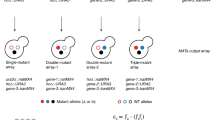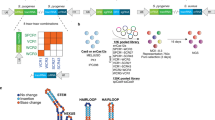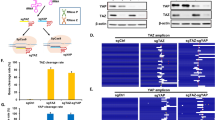Abstract
Systematic genetic interaction maps in microorganisms are powerful tools for identifying functional relationships between genes and for defining the function of uncharacterized genes. We have recently implemented this strategy in mammalian cells as a two-stage approach. First, genes of interest are robustly identified in a pooled genome-wide screen using complex shRNA libraries. Second, phenotypes for all pairwise combinations of 'hit' genes are measured in a double-shRNA screen and used to construct a genetic interaction map. Our protocol allows for rapid pooled screening under various conditions without a requirement for robotics, in contrast to arrayed approaches. Each round of screening can be implemented in ∼2 weeks, with additional time for analysis and generation of reagents. We discuss considerations for screen design, and we present complete experimental procedures, as well as a full computational analysis suite for the identification of hits in pooled screens and generation of genetic interaction maps. Although the protocol outlined here was developed for our original shRNA-based approach, it can be applied more generally, including to CRISPR-based approaches.
This is a preview of subscription content, access via your institution
Access options
Subscribe to this journal
Receive 12 print issues and online access
$259.00 per year
only $21.58 per issue
Buy this article
- Purchase on Springer Link
- Instant access to full article PDF
Prices may be subject to local taxes which are calculated during checkout







Similar content being viewed by others
Change history
16 January 2015
In the version of this article initially published, a sentence in Step 49 read "Order the top and bottom oligonucleotides corresponding to hit shRNA sequences formatted as in the example below for the target site TTTCTTACTCACCCTAAGAACT". The sentence has been corrected to replace 'target site' with 'guide sequence'. The error has been corrected in the HTML and PDF versions of the article.
References
Bandyopadhyay, S. et al. Rewiring of genetic networks in response to DNA damage. Science 330, 1385–1389 (2010).
Frost, A. et al. Functional repurposing revealed by comparing S. pombe and S. cerevisiae genetic interactions. Cell 149, 1339–1352 (2012).
Jonikas, M.C. et al. Comprehensive characterization of genes required for protein folding in the endoplasmic reticulum. Science 323, 1693–1697 (2009).
Roguev, A. et al. Conservation and rewiring of functional modules revealed by an epistasis map in fission yeast. Science 322, 405–410 (2008).
Schuldiner, M. et al. Exploration of the function and organization of the yeast early secretory pathway through an epistatic miniarray profile. Cell 123, 507–519 (2005).
Tong, A.H. et al. Systematic genetic analysis with ordered arrays of yeast deletion mutants. Science 294, 2364–2368 (2001).
Tong, A.H. et al. Global mapping of the yeast genetic interaction network. Science 303, 808–813 (2004).
Collins, S.R. et al. Functional dissection of protein complexes involved in yeast chromosome biology using a genetic interaction map. Nature 446, 806–810 (2007).
Kampmann, M., Bassik, M.C. & Weissman, J.S. Integrated platform for genome-wide screening and construction of high-density genetic interaction maps in mammalian cells. Proc. Natl. Acad. Sci. USA 110, E2317–E2326 (2013).
Bassik, M.C. et al. A systematic mammalian genetic interaction map reveals pathways underlying ricin susceptibility. Cell 152, 909–922 (2013).
Laufer, C., Fischer, B., Billmann, M., Huber, W. & Boutros, M. Mapping genetic interactions in human cancer cells with RNAi and multiparametric phenotyping. Nat. Methods 10, 427–431 (2013).
Roguev, A. et al. Quantitative genetic-interaction mapping in mammalian cells. Nat. Methods 10, 432–437 (2013).
Bassik, M.C. et al. Rapid creation and quantitative monitoring of high-coverage shRNA libraries. Nat. Methods 6, 443–445 (2009).
Kaelin, W.G. Jr. Use and abuse of RNAi to study mammalian gene function. Science 337, 421–422 (2012).
Cheung, H.W. et al. Systematic investigation of genetic vulnerabilities across cancer cell lines reveals lineage-specific dependencies in ovarian cancer. Proc. Natl. Acad. Sci. USA 108, 12372–12377 (2011).
Luo, B. et al. Highly parallel identification of essential genes in cancer cells. Proc. Natl. Acad. Sci. USA 105, 20380–20385 (2008).
Luo, J. et al. A genome-wide RNAi screen identifies multiple synthetic lethal interactions with the Ras oncogene. Cell 137, 835–848 (2009).
Zuber, J. et al. Toolkit for evaluating genes required for proliferation and survival using tetracycline-regulated RNAi. Nat. Biotechnol. 29, 79–83 (2011).
Qi, L.S. et al. Repurposing CRISPR as an RNA-guided platform for sequence-specific control of gene expression. Cell 152, 1173–1183 (2013).
Gilbert, L.A. et al. CRISPR-mediated modular RNA-guided regulation of transcription in eukaryotes. Cell 154, 442–451 (2013).
Wang, T., Wei, J.J., Sabatini, D.M. & Lander, E.S. Genetic screens in human cells using the CRISPR-Cas9 system. Science 343, 80–84 (2013).
Shalem, O. et al. Genome-scale CRISPR-Cas9 knockout screening in human cells. Science 343, 84–87 (2013).
Meerbrey, K.L. et al. The pINDUCER lentiviral toolkit for inducible RNA interference in vitro and in vivo. Proc. Natl. Acad. Sci. USA 108, 3665–3670 (2011).
Silva, J.M. et al. Profiling essential genes in human mammary cells by multiplex RNAi screening. Science 319, 617–620 (2008).
Dull, T. et al. A third-generation lentivirus vector with a conditional packaging system. J. Virol. 72, 8463–8471 (1998).
Naldini, L. et al. In vivo gene delivery and stable transduction of nondividing cells by a lentiviral vector. Science 272, 263–267 (1996).
Saldanha, A.J. Java TreeView: extensible visualization of microarray data. Bioinformatics 20, 3246–3248 (2004).
Matheny, C.J. et al. Next-generation NAMPT inhibitors identified by sequential high-throughput phenotypic chemical and functional genomic screens. Chem. Biol. 20, 1352–1363 (2013).
Eisen, M.B., Spellman, P.T., Brown, P.O. & Botstein, D. Cluster analysis and display of genome-wide expression patterns. Proc. Natl. Acad. Sci. USA 95, 14863–14868 (1998).
Acknowledgements
We thank E. LeProust and S. Chen of Agilent Technologies for oligonucleotide libraries; Y. Chen and S. Wang for their technical assistance and feedback on the protocol; M. Horlbeck for testing pMK1200; Y. Chen, M. Horlbeck and L. Gilbert for sharing gel images; and S. Collins for helpful discussions on data analysis. M.K. was funded by fellowships from the Jane Coffin Childs Memorial Fund for Medical Research and the University of California, San Francisco Program for Breakthrough Biomedical Research; M.C.B. was funded by a fellowship from the Leukemia and Lymphoma Society; J.S.W. was funded by the Howard Hughes Medical Institute, National Institutes of Health Grant no. 1U01CA168370-01, and a Howard Hughes Collaborative Initiative Award.
Author information
Authors and Affiliations
Contributions
M.K., M.C.B. and J.S.W. designed the study; M.K. and M.C.B. developed the experimental methods; M.K. developed the quantitative framework and scripts for computational analysis; M.K., M.C.B. and J.S.W. wrote the manuscript.
Corresponding authors
Ethics declarations
Competing interests
The authors declare no competing financial interests.
Integrated supplementary information
Supplementary Figure 1 Graphical output of the script analyze_primary_screen.py.
(a) Histogram of the number of shRNAs per gene for which growth phenotypes (gammas) could be calculated. (b) Cumulative distributions of growth phenotypes (gammas) for negative control shRNAs (blue dots) and shRNAs designed to target genes (red dots).
Supplementary Figure 2 Graphical output of the script analyze_primary_screen.py.
Each dot represents one gene. Log10-transformed P values for an effect caused by gene knockdown were calculated by the Mann-Whitney test (X axis) or the Kolmogorov-Smirnov test (Y axis)9. Negative values indicate depletion of cells expressing shRNAs targeting the gene of interest from the population, positive values indicate enrichment.
Supplementary Figure 3 Graphical output of the script double_shRNA_phenotypes.py.
(a) The histogram shows the distribution of differences between the double-shRNA phenotypes (rho) of two shRNAs, A and B, in the AB versus the BA orientation. Since these phenotypes should be identical, AB-BA differences are a measure for experimental noise. (b) A two-dimensional histogram (implemented as hexagonally binned heatmap) of AB-BA differences in phenotype (rho) as a function of the average phenotype of the AB and BA double-shRNAs.
Supplementary Figure 4 Graphical output of the script double_shRNA_phenotypes.py.
Comparison of double-shRNA phenotype for combinations of a given shRNA targeting a gene, with negative control shRNAs in either orientation. Dots represent the average across combinations with all 12 negative control shRNAs in the double-shRNA library; error bars represent the standard deviation. The red line indicates the empirical linear fit of the data, the corresponding equation is given above the graph. The grey line represents unity.
Supplementary Figure 5 Graphical output of the script calculate_GIs.py.
(a) X-axis: phenotypes of shRNAs in combination with negative control shRNAs (which we have shown to be generally identical to single-shRNA phenotypes10). Y-axis: slope of a linear fit of double-shRNA phenotypes containing the shRNA of interest as a function of single-shRNA phenotypes (as shown in Figure 7 and Supplementary Figure 6). Dots represent values averaged for shRNAs targeting the same gene, and error bars represent standard deviation. If the product model were correct for describing expected double-shRNA phenotypes, the data points would be expected to fall on the green line. If the sum model were correct for describing expected double-shRNA phenotypes, the data points would be expected to fall on the orange line. (b) Graphical output of the script calculate_GIs.py. Slopes of a linear fit of double-shRNA phenotypes containing the shRNA of interest as a function of single-shRNA phenotypes (as shown in Figure 7 and Supplementary Figure 6). Dots represent values averaged for shRNAs targeting the same gene, and error bars represent standard deviation. X axis: fit across rows in the double-shRNA phenotype table. Y axis: fit across columns in the double-shRNA phenotype table. The pink line indicates the empirical linear fit of the data, and its corresponding equation is given above the graph. The grey line represents unity.
Supplementary Figure 6 Graphical output of the script calculate_GIs.py.
(a) This graph was generated interactively using the rho_sd() command after running the script. Each dot represents an shRNA. X axis: average phenotype (rho) of double-shRNAs containing this shRNA and one of 12 negative control shRNAs. Y axis: phenotype (rho) of the double-shRNA containing the same shRNA in combination with shRNA SEC23B_4. Blue dots: SEC23B_4 is in the first position of the double shRNA, red dots: SEC23B_4 is in the second position of the double shRNA. Dotted blue and red lines indicate phenotypes of SEC23B_4 in combination with negative control shRNAs. If the shRNA combined with SEC23B_4 had no effect, dots should lie on the dotted lines. Solid blue and red lines represent linear fits of the data points. These lines were forced to cross the dotted lines at X = 0. Permutated pairs of shRNAs are linked by lines (for double shRNAs deviating from the expected double-shRNA phenotype as defined by the solid red and blue lines). (b) This graph was generated interactively using the gene_rho_sd() command after running the script. Same as (a), except that values for shRNAs targeting the same gene are averaged. Error bars represent the standard deviation.
Supplementary Figure 7 Graphical output of the script compare_GIs.py
(a) A two-dimensional histogram (implemented as hexagonally binned heatmap) of genetic interactions calculated for shRNA pairs in two experimental replicates, Rep1 and Rep2. (b) Histogram visualizing the Pearson correlation for genetic interactions between experimental replicates, based on different methods to calculated genetic interactions, as defined in ref. 9. (c) Graphical output of the script compare_GIs.py. Histogram visualizing the mean genetic interactions, based on different methods to calculated genetic interactions, as defined in ref. 9. Genetic interactions were averaged between experimental replicates. (d) Graphical output of the script compare_GIs.py. Comparison of average correlation between genetic interaction patterns of shRNAs targeting the same gene (X axis) or different genes (Y axis), based on different methods to calculated genetic interactions, as defined in ref. 9. Appropriate methods for calculating genetic interactions should yield high correlations between shRNAs targeting the same gene.
Supplementary Figure 8 Graphical output of the script filter_GIs.py.
Heat-map visualizing the frequencies of genes with particular distribution of shRNAs that either passed the filter of sufficient correlation of genetic interaction pattern with other shRNAs targeting the same gene (“correlated shRNAs”) or not (“uncorrelated shRNAs”). Only genes with at least 2 correlated shRNAs are included in the final genetic interaction map.
Supplementary information
Supplementary Figure 1
Graphical output of the script analyze_primary_screen.py. (PDF 400 kb)
Supplementary Figure 2
Graphical output of the script analyze_primary_screen.py. (PDF 5296 kb)
Supplementary Figure 3
Graphical output of the script double_shRNA_phenotypes.py. (PDF 1378 kb)
Supplementary Figure 4
Graphical output of the script double_shRNA_phenotypes.py. (PDF 410 kb)
Supplementary Figure 5
Graphical output of the script calculate_GIs.py. (PDF 841 kb)
Supplementary Figure 6
Graphical output of the script calculate_GIs.py. (PDF 608 kb)
Supplementary Figure 7
Graphical output of the script compare_GIs.py. (PDF 1500 kb)
Supplementary Figure 8
Graphical output of the script filter_GIs.py. (PDF 364 kb)
Supplementary Table 1
Oligonucleotide sequences. Illumina index sequences are shown in red. (PDF 153 kb)
Supplementary Data 1
Sequence of pMK1047, the backbone used for primary shRNA screens9,10. (PDF 203 kb)
Supplementary Data 2
Sequence of pMK1200, the backbone used for cloning and barcoding of individual shRNAs9. (PDF 246 kb)
Rights and permissions
About this article
Cite this article
Kampmann, M., Bassik, M. & Weissman, J. Functional genomics platform for pooled screening and generation of mammalian genetic interaction maps. Nat Protoc 9, 1825–1847 (2014). https://doi.org/10.1038/nprot.2014.103
Published:
Issue Date:
DOI: https://doi.org/10.1038/nprot.2014.103
This article is cited by
-
Compact CRISPR genetic screens enabled by improved guide RNA library cloning
Genome Biology (2024)
-
Gene expression and cell identity controlled by anaphase-promoting complex
Nature (2020)
-
Lysosome-targeting chimaeras for degradation of extracellular proteins
Nature (2020)
-
A glance at genome editing with CRISPR–Cas9 technology
Current Genetics (2020)
-
SLC19A1 transports immunoreactive cyclic dinucleotides
Nature (2019)
Comments
By submitting a comment you agree to abide by our Terms and Community Guidelines. If you find something abusive or that does not comply with our terms or guidelines please flag it as inappropriate.




